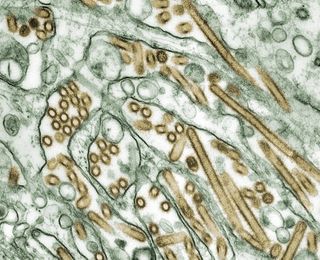Bird Flu Pandemic: How Likely Is a Deadly Outbreak?

Controversial new research shows that with just a handful of mutations, the deadly bird flu virus could spread in an airborne fashion between mammals.
Just five changes in the structure of the H5N1 virus could give it the ability to spread via airborne particles — a change that brings the potential for a pandemic — and two of those changes can already be found in circulating strains of the virus, according to findings to be published tomorrow (June 22) in the journal Science.
But how likely is it that these changes would actually happen in nature and unleash a global outbreak?
"We know that it's possible for these remaining mutations to evolve within an infected host," said lead author Colin Russell, a zoologist at the University of Cambridge, speaking at a news conference in advance the papers' release.
In other words, it is possible that within the body of one infected mammal, the virus could mutate to a point where it can spread directly to other mammals – a barrier that thus far has kept bird flu spreading from person to person.
But while the new research gives scientists a picture of what such an airborne virus looks like, and how close existing strains have come to resembling that virus, further research needs to be done to determine how likely it is that those further changes will occur.
Avian influenza was first linked to human infections in Hong Kong in 1997. Since then, a few hundred cases have been reported, with 60 percent of infected people dying from the virus.
Sign up for the Live Science daily newsletter now
Get the world’s most fascinating discoveries delivered straight to your inbox.
In future research, investigators should increase their surveillance of the virus in parts of the world where animals that contract the virus live in groups, and where some of the mutations have been seen, as those are the places the pandemic form of the virus is likely to arise, the researchers said.
As to why the mutations have not already occurred, Russell said, "It could be a situation where we've just been lucky so far, or it could be a situation where it's actually something that's challenging to do."
It's difficult to determine how long it might take before a strain that could spread through the air between humans evolves, said Derek Smith, a professor of infectious disease informatics at Cambridge and the paper's senior author.
The risk of the five mutations occurring in a single host could be one in a thousand, or one in 100 million, Smith said.
The risk of the mutations actually taking place is related to how helpful they are for the virus to spread, he explained. The two mutations that have already been found with some frequency in bird flu viruses in the wild are likely helpful or neutral for the virus’s spread, while the other three probably do not help it spread in birds, and would occur only when in an infected mammalian host.
The new research on the mutations was conducted in ferrets, which have similar sensitivity to the virus as humans, but are not a perfect model of human flu.
While the chance of mutations occurring in nature remains small, another possibility is that people trying to develop bioweapons would alter the virus to make it more virulent. This is one of the reasons why publication of the research has been hotly debated.
Even trying to build an influenza weapon might be a poor choice. Given the difficulty in controlling the virus' spread, would-be terrorists could easily find it afflicting them, Dr. William Schaffner, chairman of the department of preventive medicine at Vanderbilt University School of Medicine, told MyHealthNewsDaily.
The larger risk of a pandemic, Schaffner said, comes from the possibility of an infection coming out of labs researching the virus. Measures must be taken to make sure that doesn't happen, he said.
While risky, Schaffner said, there are benefits of research on the virus: a greater chance of catching outbreaks early, better information for vaccine manufacturers and the potential ability to produce better antiviral drugs for infected people.
Pass it on: Five mutations are needed for the bird flu virus to become airborne, but researchers still aren't sure how likely that is to happen.
Follow MyHealthNewsDaily on Twitter @MyHealth_MHND. We're also on Facebook & Google+.
Most Popular

